ELTAC Unit 4 Assignment: Skills in ELT - Summary Writing Activity
VerifiedAdded on 2022/11/07
|8
|2311
|309
Homework Assignment
AI Summary
This assignment presents an activity plan for teaching summary writing to B1 level learners (age 8-10, Grade 3) as part of an ELTAC Unit 4 assignment. The plan focuses on the four language skills (LSRW), specifically addressing phonological, syntactic, and lexical aspects of English. The activity, called 'summary mapping,' utilizes a story titled 'Saving the Birds' to teach summarization techniques. The plan includes objectives aligned with the CEFR, a detailed description of the activity, an analysis of potential challenges and barriers, and the integration of speaking skills. The assignment emphasizes the importance of identifying characters, problems, and solutions to create concise summaries. It also considers sociolinguistic factors and the use of appropriate terminology for young learners. The assessment focuses on the accuracy of the summary in representing the key elements of the story. The assignment concludes with references and the full text of the story used in the activity.
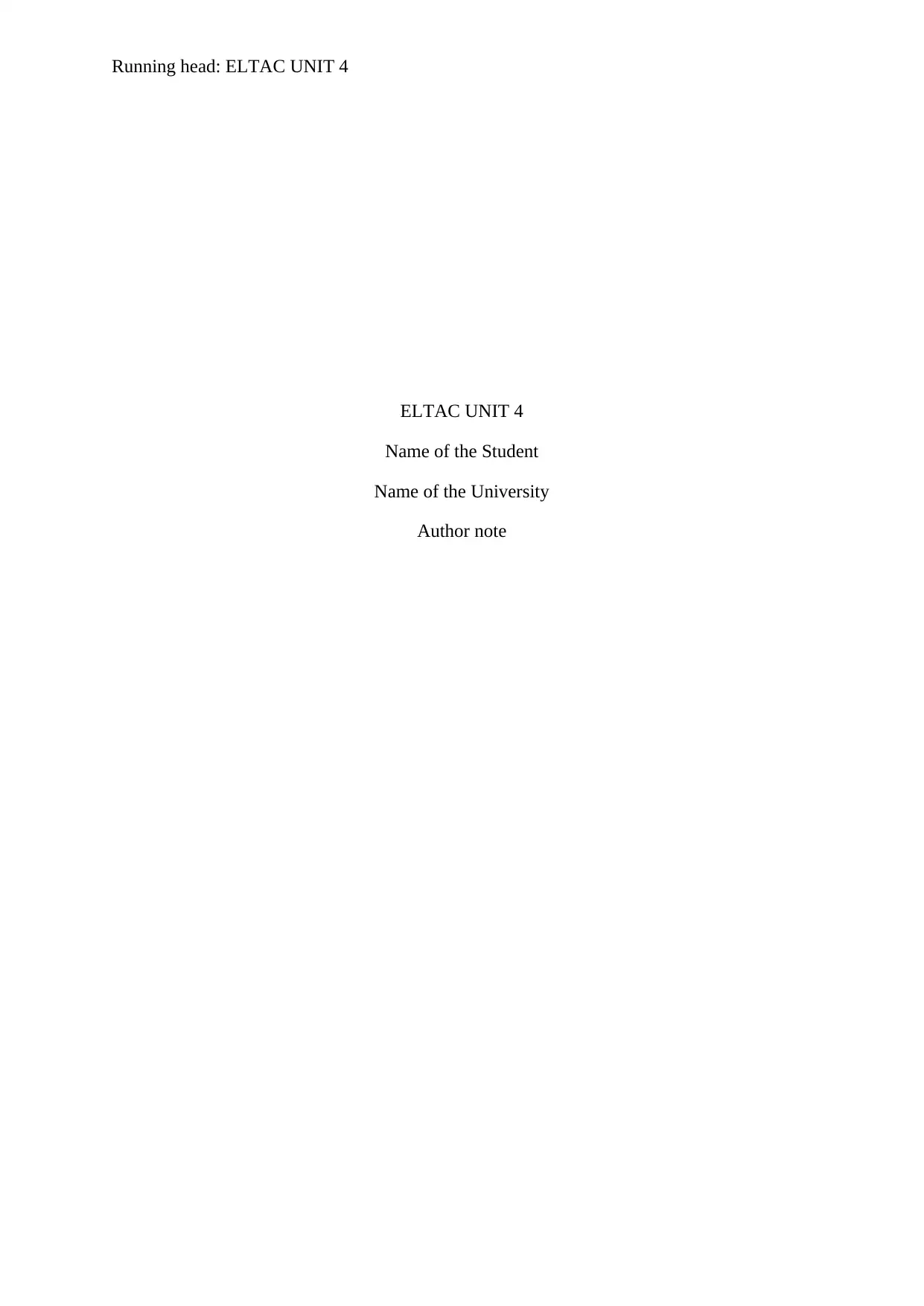
Running head: ELTAC UNIT 4
ELTAC UNIT 4
Name of the Student
Name of the University
Author note
ELTAC UNIT 4
Name of the Student
Name of the University
Author note
Paraphrase This Document
Need a fresh take? Get an instant paraphrase of this document with our AI Paraphraser
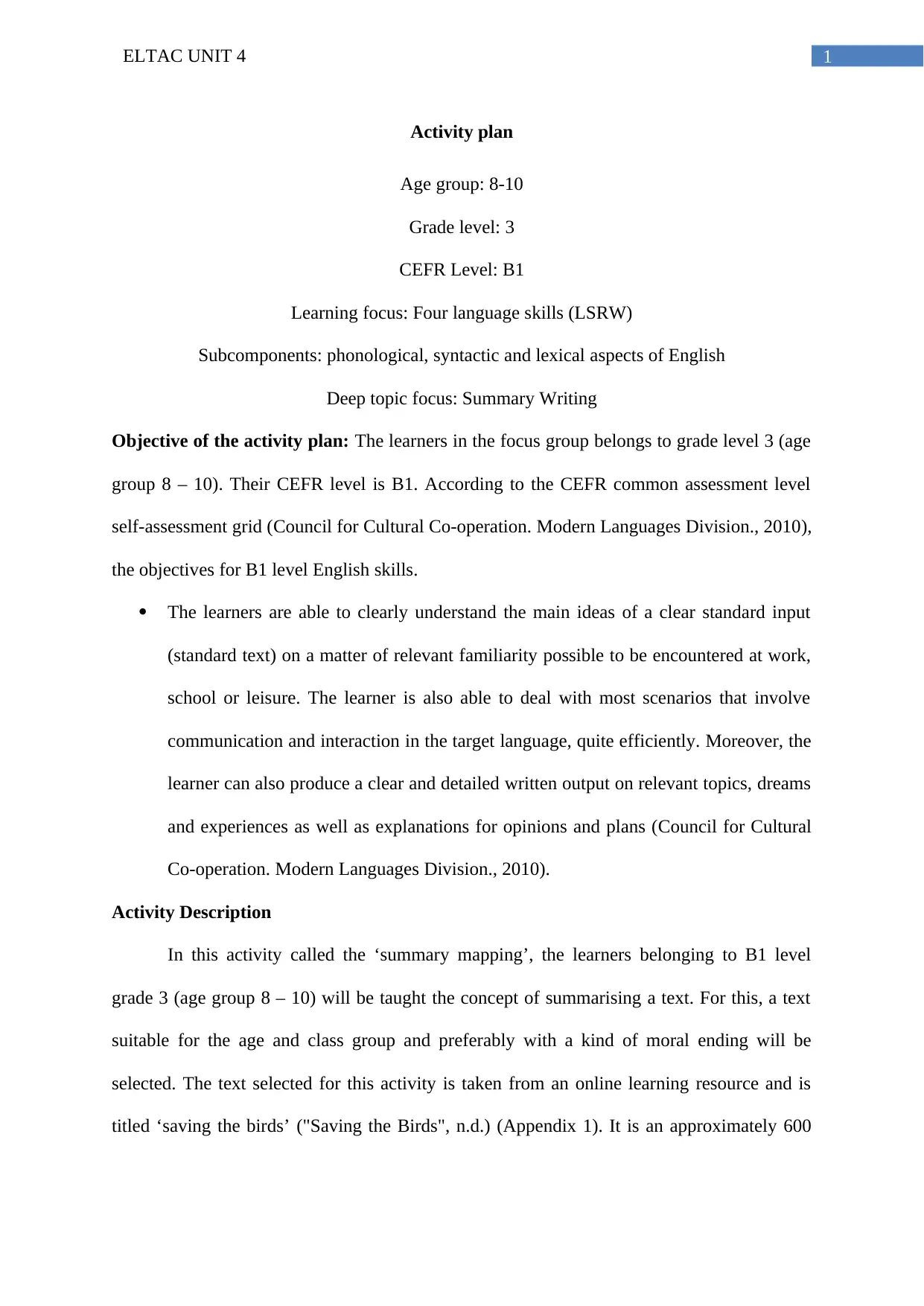
1ELTAC UNIT 4
Activity plan
Age group: 8-10
Grade level: 3
CEFR Level: B1
Learning focus: Four language skills (LSRW)
Subcomponents: phonological, syntactic and lexical aspects of English
Deep topic focus: Summary Writing
Objective of the activity plan: The learners in the focus group belongs to grade level 3 (age
group 8 – 10). Their CEFR level is B1. According to the CEFR common assessment level
self-assessment grid (Council for Cultural Co-operation. Modern Languages Division., 2010),
the objectives for B1 level English skills.
The learners are able to clearly understand the main ideas of a clear standard input
(standard text) on a matter of relevant familiarity possible to be encountered at work,
school or leisure. The learner is also able to deal with most scenarios that involve
communication and interaction in the target language, quite efficiently. Moreover, the
learner can also produce a clear and detailed written output on relevant topics, dreams
and experiences as well as explanations for opinions and plans (Council for Cultural
Co-operation. Modern Languages Division., 2010).
Activity Description
In this activity called the ‘summary mapping’, the learners belonging to B1 level
grade 3 (age group 8 – 10) will be taught the concept of summarising a text. For this, a text
suitable for the age and class group and preferably with a kind of moral ending will be
selected. The text selected for this activity is taken from an online learning resource and is
titled ‘saving the birds’ ("Saving the Birds", n.d.) (Appendix 1). It is an approximately 600
Activity plan
Age group: 8-10
Grade level: 3
CEFR Level: B1
Learning focus: Four language skills (LSRW)
Subcomponents: phonological, syntactic and lexical aspects of English
Deep topic focus: Summary Writing
Objective of the activity plan: The learners in the focus group belongs to grade level 3 (age
group 8 – 10). Their CEFR level is B1. According to the CEFR common assessment level
self-assessment grid (Council for Cultural Co-operation. Modern Languages Division., 2010),
the objectives for B1 level English skills.
The learners are able to clearly understand the main ideas of a clear standard input
(standard text) on a matter of relevant familiarity possible to be encountered at work,
school or leisure. The learner is also able to deal with most scenarios that involve
communication and interaction in the target language, quite efficiently. Moreover, the
learner can also produce a clear and detailed written output on relevant topics, dreams
and experiences as well as explanations for opinions and plans (Council for Cultural
Co-operation. Modern Languages Division., 2010).
Activity Description
In this activity called the ‘summary mapping’, the learners belonging to B1 level
grade 3 (age group 8 – 10) will be taught the concept of summarising a text. For this, a text
suitable for the age and class group and preferably with a kind of moral ending will be
selected. The text selected for this activity is taken from an online learning resource and is
titled ‘saving the birds’ ("Saving the Birds", n.d.) (Appendix 1). It is an approximately 600
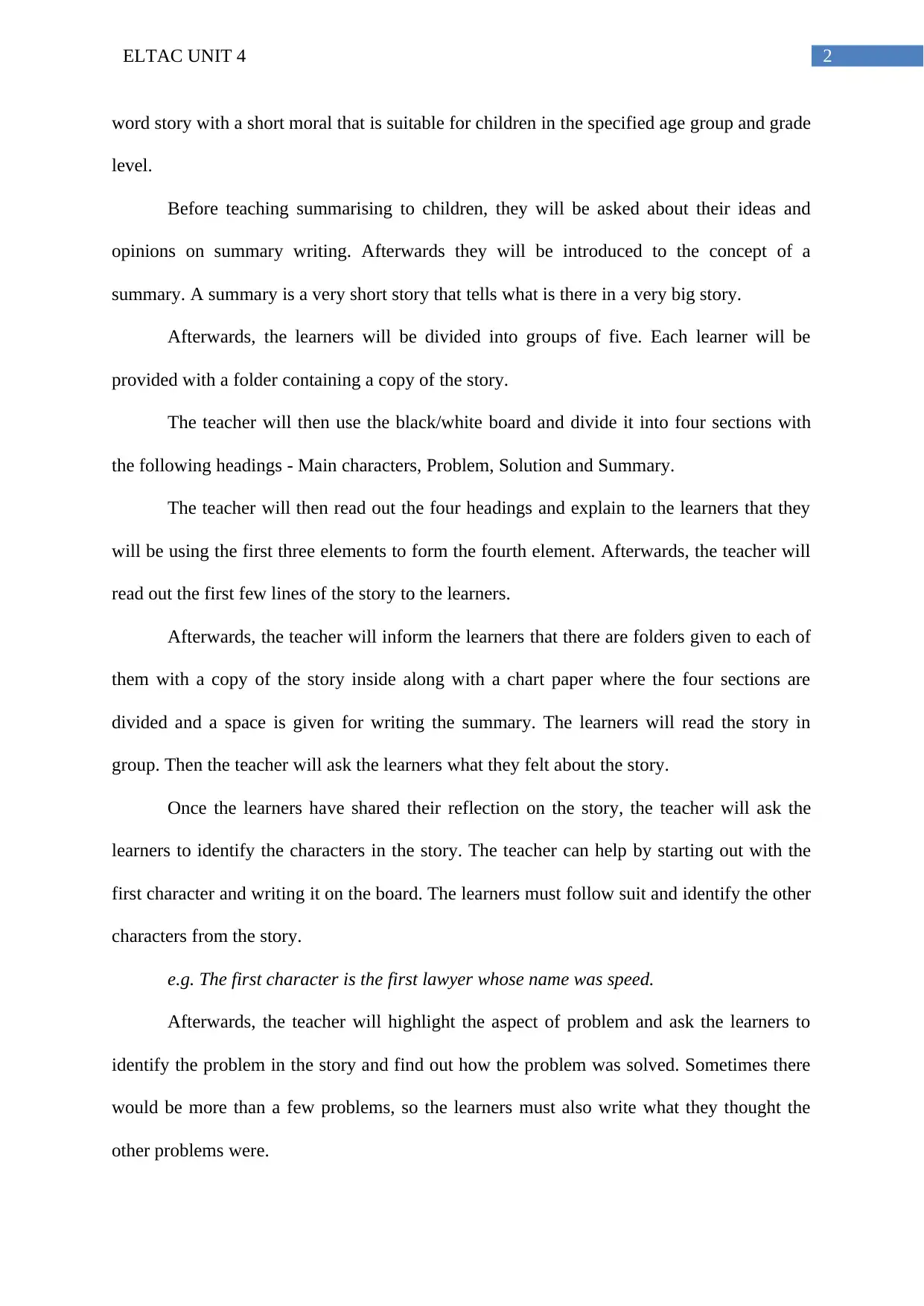
2ELTAC UNIT 4
word story with a short moral that is suitable for children in the specified age group and grade
level.
Before teaching summarising to children, they will be asked about their ideas and
opinions on summary writing. Afterwards they will be introduced to the concept of a
summary. A summary is a very short story that tells what is there in a very big story.
Afterwards, the learners will be divided into groups of five. Each learner will be
provided with a folder containing a copy of the story.
The teacher will then use the black/white board and divide it into four sections with
the following headings - Main characters, Problem, Solution and Summary.
The teacher will then read out the four headings and explain to the learners that they
will be using the first three elements to form the fourth element. Afterwards, the teacher will
read out the first few lines of the story to the learners.
Afterwards, the teacher will inform the learners that there are folders given to each of
them with a copy of the story inside along with a chart paper where the four sections are
divided and a space is given for writing the summary. The learners will read the story in
group. Then the teacher will ask the learners what they felt about the story.
Once the learners have shared their reflection on the story, the teacher will ask the
learners to identify the characters in the story. The teacher can help by starting out with the
first character and writing it on the board. The learners must follow suit and identify the other
characters from the story.
e.g. The first character is the first lawyer whose name was speed.
Afterwards, the teacher will highlight the aspect of problem and ask the learners to
identify the problem in the story and find out how the problem was solved. Sometimes there
would be more than a few problems, so the learners must also write what they thought the
other problems were.
word story with a short moral that is suitable for children in the specified age group and grade
level.
Before teaching summarising to children, they will be asked about their ideas and
opinions on summary writing. Afterwards they will be introduced to the concept of a
summary. A summary is a very short story that tells what is there in a very big story.
Afterwards, the learners will be divided into groups of five. Each learner will be
provided with a folder containing a copy of the story.
The teacher will then use the black/white board and divide it into four sections with
the following headings - Main characters, Problem, Solution and Summary.
The teacher will then read out the four headings and explain to the learners that they
will be using the first three elements to form the fourth element. Afterwards, the teacher will
read out the first few lines of the story to the learners.
Afterwards, the teacher will inform the learners that there are folders given to each of
them with a copy of the story inside along with a chart paper where the four sections are
divided and a space is given for writing the summary. The learners will read the story in
group. Then the teacher will ask the learners what they felt about the story.
Once the learners have shared their reflection on the story, the teacher will ask the
learners to identify the characters in the story. The teacher can help by starting out with the
first character and writing it on the board. The learners must follow suit and identify the other
characters from the story.
e.g. The first character is the first lawyer whose name was speed.
Afterwards, the teacher will highlight the aspect of problem and ask the learners to
identify the problem in the story and find out how the problem was solved. Sometimes there
would be more than a few problems, so the learners must also write what they thought the
other problems were.
⊘ This is a preview!⊘
Do you want full access?
Subscribe today to unlock all pages.

Trusted by 1+ million students worldwide
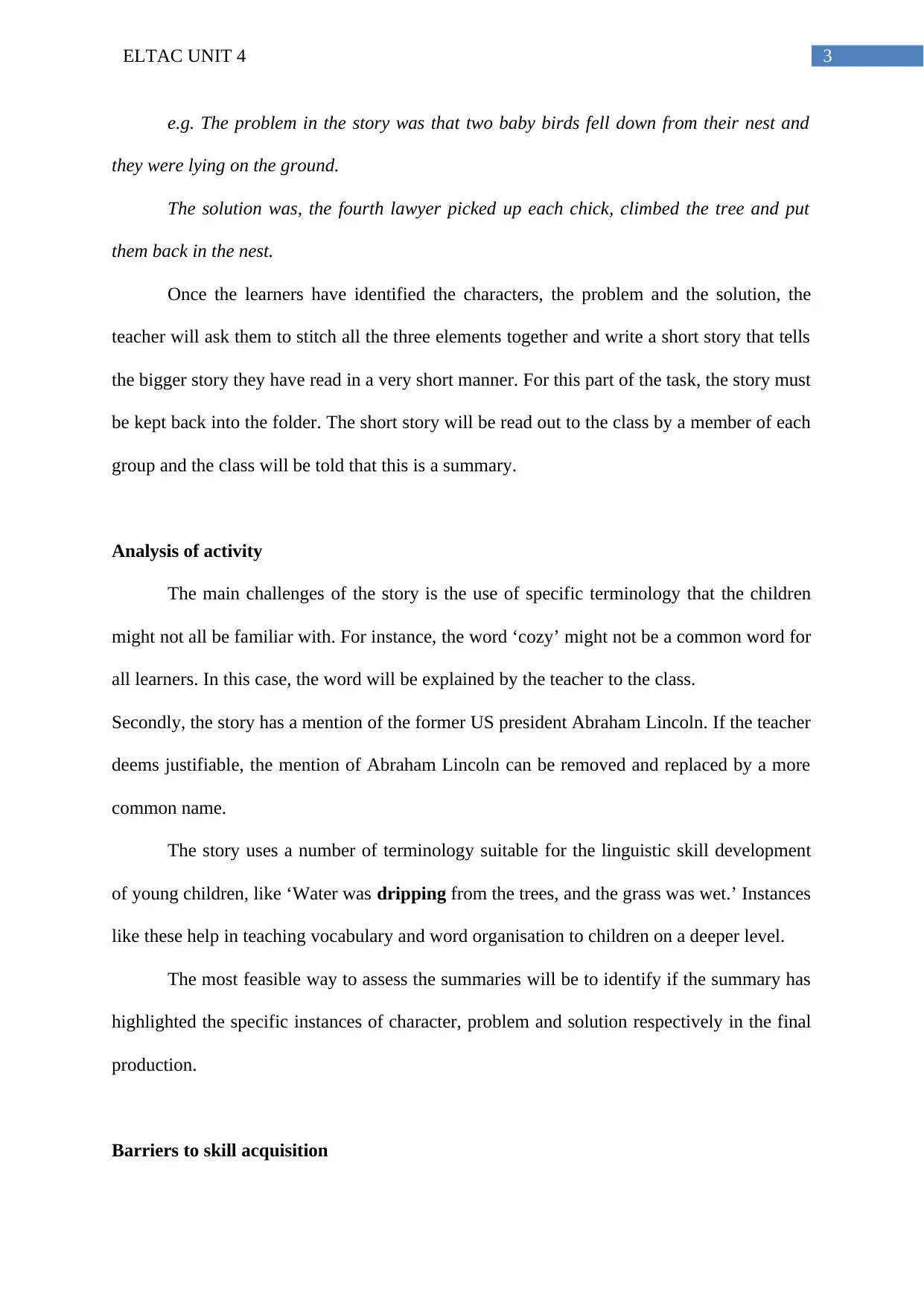
3ELTAC UNIT 4
e.g. The problem in the story was that two baby birds fell down from their nest and
they were lying on the ground.
The solution was, the fourth lawyer picked up each chick, climbed the tree and put
them back in the nest.
Once the learners have identified the characters, the problem and the solution, the
teacher will ask them to stitch all the three elements together and write a short story that tells
the bigger story they have read in a very short manner. For this part of the task, the story must
be kept back into the folder. The short story will be read out to the class by a member of each
group and the class will be told that this is a summary.
Analysis of activity
The main challenges of the story is the use of specific terminology that the children
might not all be familiar with. For instance, the word ‘cozy’ might not be a common word for
all learners. In this case, the word will be explained by the teacher to the class.
Secondly, the story has a mention of the former US president Abraham Lincoln. If the teacher
deems justifiable, the mention of Abraham Lincoln can be removed and replaced by a more
common name.
The story uses a number of terminology suitable for the linguistic skill development
of young children, like ‘Water was dripping from the trees, and the grass was wet.’ Instances
like these help in teaching vocabulary and word organisation to children on a deeper level.
The most feasible way to assess the summaries will be to identify if the summary has
highlighted the specific instances of character, problem and solution respectively in the final
production.
Barriers to skill acquisition
e.g. The problem in the story was that two baby birds fell down from their nest and
they were lying on the ground.
The solution was, the fourth lawyer picked up each chick, climbed the tree and put
them back in the nest.
Once the learners have identified the characters, the problem and the solution, the
teacher will ask them to stitch all the three elements together and write a short story that tells
the bigger story they have read in a very short manner. For this part of the task, the story must
be kept back into the folder. The short story will be read out to the class by a member of each
group and the class will be told that this is a summary.
Analysis of activity
The main challenges of the story is the use of specific terminology that the children
might not all be familiar with. For instance, the word ‘cozy’ might not be a common word for
all learners. In this case, the word will be explained by the teacher to the class.
Secondly, the story has a mention of the former US president Abraham Lincoln. If the teacher
deems justifiable, the mention of Abraham Lincoln can be removed and replaced by a more
common name.
The story uses a number of terminology suitable for the linguistic skill development
of young children, like ‘Water was dripping from the trees, and the grass was wet.’ Instances
like these help in teaching vocabulary and word organisation to children on a deeper level.
The most feasible way to assess the summaries will be to identify if the summary has
highlighted the specific instances of character, problem and solution respectively in the final
production.
Barriers to skill acquisition
Paraphrase This Document
Need a fresh take? Get an instant paraphrase of this document with our AI Paraphraser
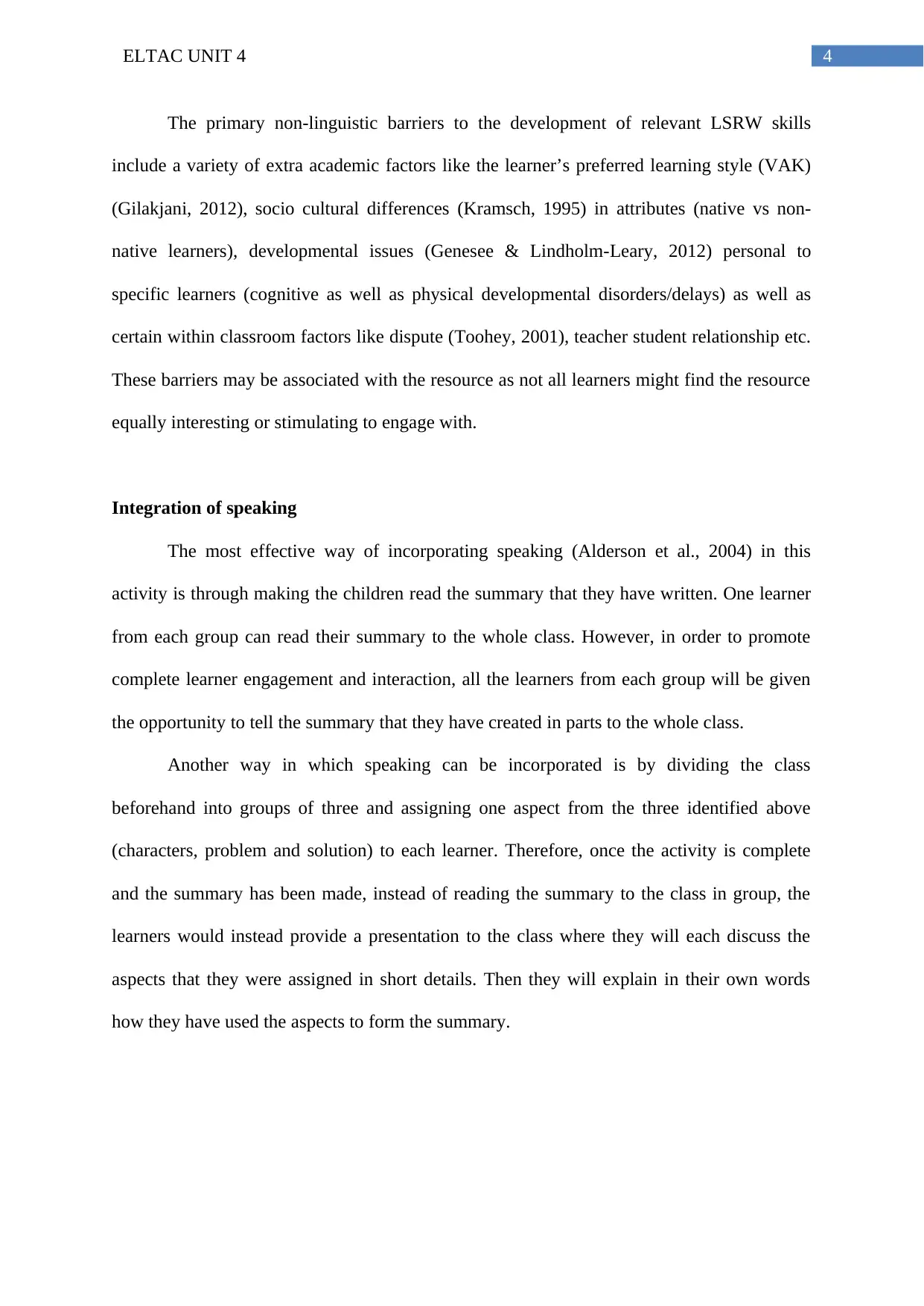
4ELTAC UNIT 4
The primary non-linguistic barriers to the development of relevant LSRW skills
include a variety of extra academic factors like the learner’s preferred learning style (VAK)
(Gilakjani, 2012), socio cultural differences (Kramsch, 1995) in attributes (native vs non-
native learners), developmental issues (Genesee & Lindholm-Leary, 2012) personal to
specific learners (cognitive as well as physical developmental disorders/delays) as well as
certain within classroom factors like dispute (Toohey, 2001), teacher student relationship etc.
These barriers may be associated with the resource as not all learners might find the resource
equally interesting or stimulating to engage with.
Integration of speaking
The most effective way of incorporating speaking (Alderson et al., 2004) in this
activity is through making the children read the summary that they have written. One learner
from each group can read their summary to the whole class. However, in order to promote
complete learner engagement and interaction, all the learners from each group will be given
the opportunity to tell the summary that they have created in parts to the whole class.
Another way in which speaking can be incorporated is by dividing the class
beforehand into groups of three and assigning one aspect from the three identified above
(characters, problem and solution) to each learner. Therefore, once the activity is complete
and the summary has been made, instead of reading the summary to the class in group, the
learners would instead provide a presentation to the class where they will each discuss the
aspects that they were assigned in short details. Then they will explain in their own words
how they have used the aspects to form the summary.
The primary non-linguistic barriers to the development of relevant LSRW skills
include a variety of extra academic factors like the learner’s preferred learning style (VAK)
(Gilakjani, 2012), socio cultural differences (Kramsch, 1995) in attributes (native vs non-
native learners), developmental issues (Genesee & Lindholm-Leary, 2012) personal to
specific learners (cognitive as well as physical developmental disorders/delays) as well as
certain within classroom factors like dispute (Toohey, 2001), teacher student relationship etc.
These barriers may be associated with the resource as not all learners might find the resource
equally interesting or stimulating to engage with.
Integration of speaking
The most effective way of incorporating speaking (Alderson et al., 2004) in this
activity is through making the children read the summary that they have written. One learner
from each group can read their summary to the whole class. However, in order to promote
complete learner engagement and interaction, all the learners from each group will be given
the opportunity to tell the summary that they have created in parts to the whole class.
Another way in which speaking can be incorporated is by dividing the class
beforehand into groups of three and assigning one aspect from the three identified above
(characters, problem and solution) to each learner. Therefore, once the activity is complete
and the summary has been made, instead of reading the summary to the class in group, the
learners would instead provide a presentation to the class where they will each discuss the
aspects that they were assigned in short details. Then they will explain in their own words
how they have used the aspects to form the summary.
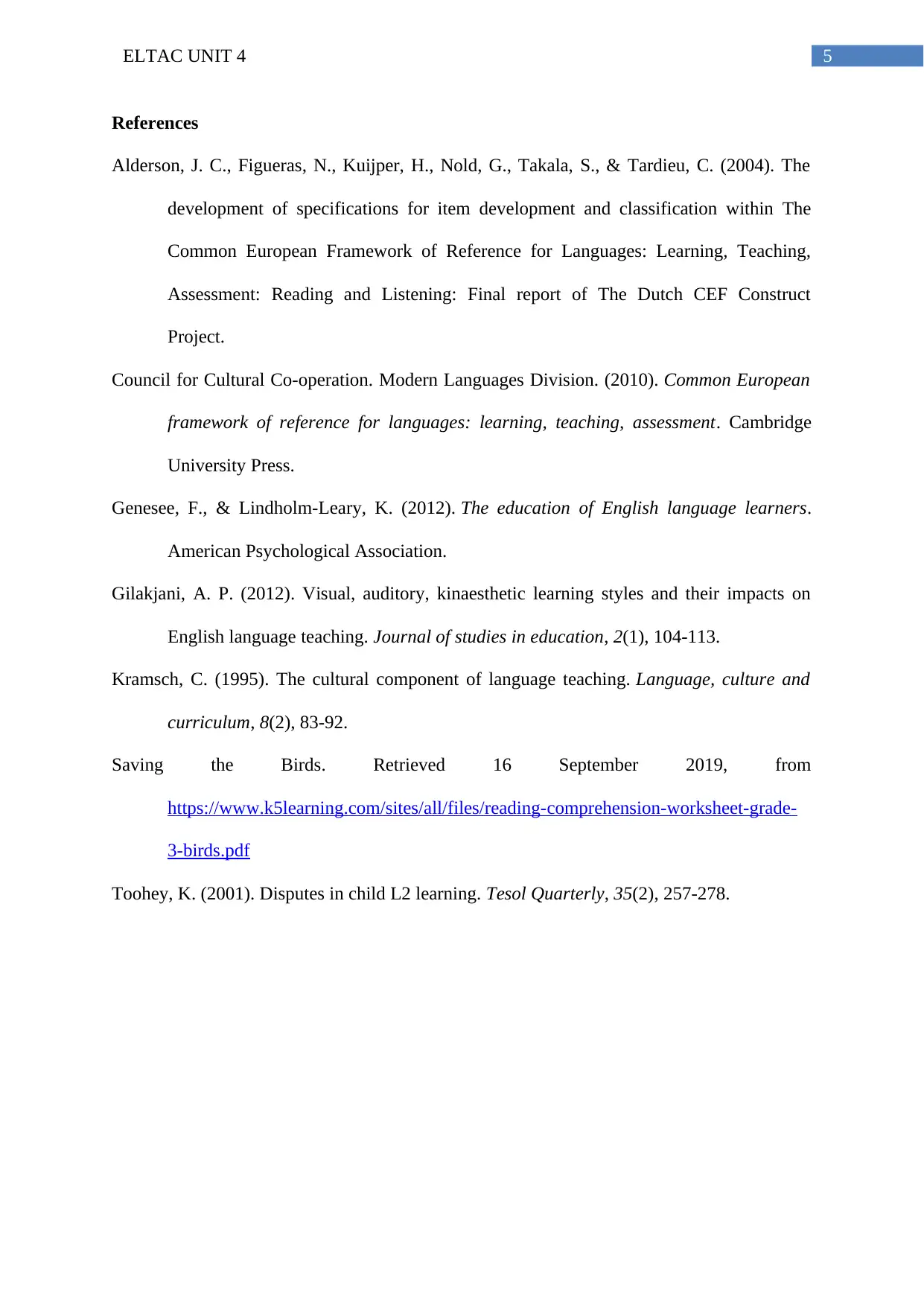
5ELTAC UNIT 4
References
Alderson, J. C., Figueras, N., Kuijper, H., Nold, G., Takala, S., & Tardieu, C. (2004). The
development of specifications for item development and classification within The
Common European Framework of Reference for Languages: Learning, Teaching,
Assessment: Reading and Listening: Final report of The Dutch CEF Construct
Project.
Council for Cultural Co-operation. Modern Languages Division. (2010). Common European
framework of reference for languages: learning, teaching, assessment. Cambridge
University Press.
Genesee, F., & Lindholm-Leary, K. (2012). The education of English language learners.
American Psychological Association.
Gilakjani, A. P. (2012). Visual, auditory, kinaesthetic learning styles and their impacts on
English language teaching. Journal of studies in education, 2(1), 104-113.
Kramsch, C. (1995). The cultural component of language teaching. Language, culture and
curriculum, 8(2), 83-92.
Saving the Birds. Retrieved 16 September 2019, from
https://www.k5learning.com/sites/all/files/reading-comprehension-worksheet-grade-
3-birds.pdf
Toohey, K. (2001). Disputes in child L2 learning. Tesol Quarterly, 35(2), 257-278.
References
Alderson, J. C., Figueras, N., Kuijper, H., Nold, G., Takala, S., & Tardieu, C. (2004). The
development of specifications for item development and classification within The
Common European Framework of Reference for Languages: Learning, Teaching,
Assessment: Reading and Listening: Final report of The Dutch CEF Construct
Project.
Council for Cultural Co-operation. Modern Languages Division. (2010). Common European
framework of reference for languages: learning, teaching, assessment. Cambridge
University Press.
Genesee, F., & Lindholm-Leary, K. (2012). The education of English language learners.
American Psychological Association.
Gilakjani, A. P. (2012). Visual, auditory, kinaesthetic learning styles and their impacts on
English language teaching. Journal of studies in education, 2(1), 104-113.
Kramsch, C. (1995). The cultural component of language teaching. Language, culture and
curriculum, 8(2), 83-92.
Saving the Birds. Retrieved 16 September 2019, from
https://www.k5learning.com/sites/all/files/reading-comprehension-worksheet-grade-
3-birds.pdf
Toohey, K. (2001). Disputes in child L2 learning. Tesol Quarterly, 35(2), 257-278.
⊘ This is a preview!⊘
Do you want full access?
Subscribe today to unlock all pages.

Trusted by 1+ million students worldwide
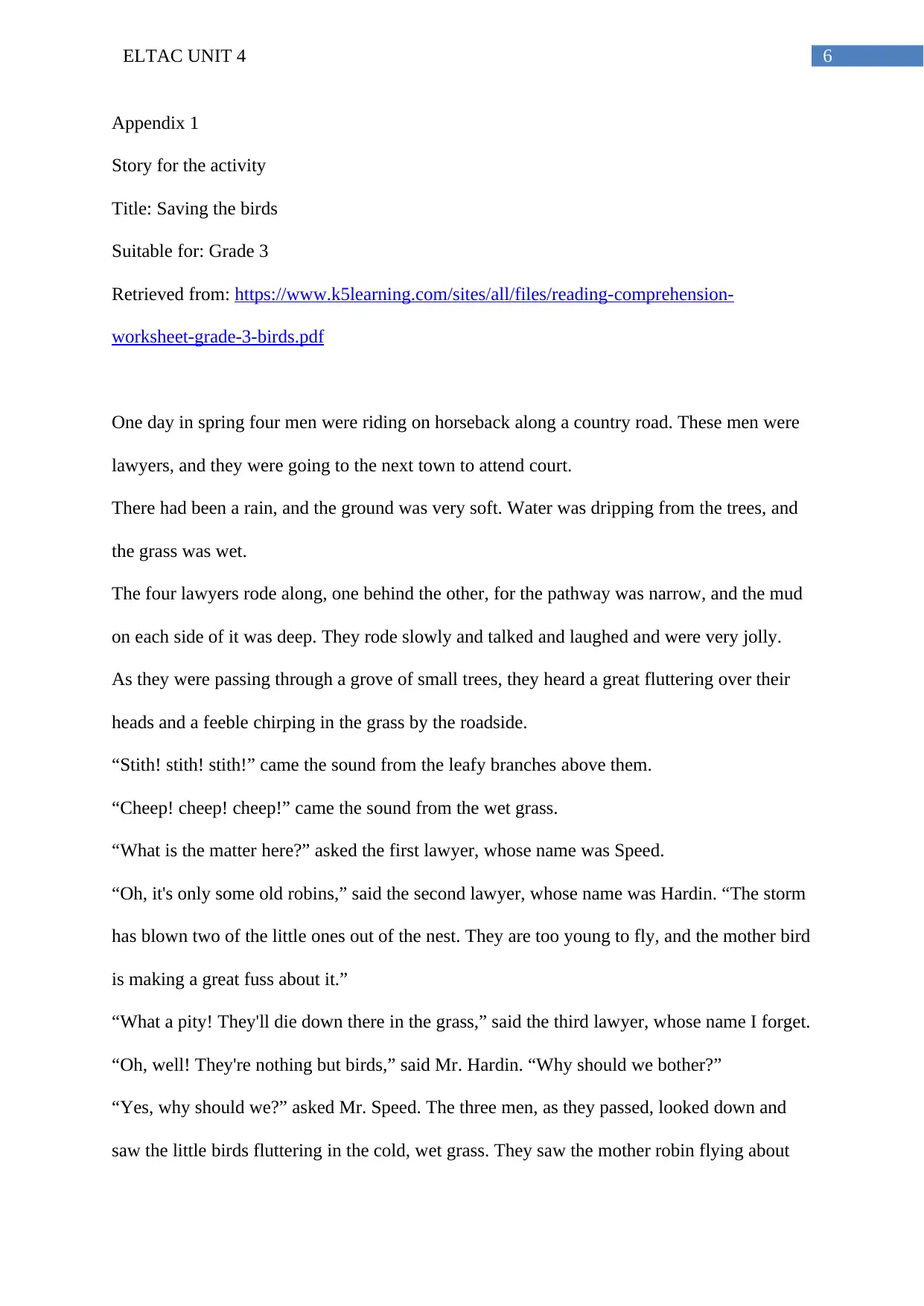
6ELTAC UNIT 4
Appendix 1
Story for the activity
Title: Saving the birds
Suitable for: Grade 3
Retrieved from: https://www.k5learning.com/sites/all/files/reading-comprehension-
worksheet-grade-3-birds.pdf
One day in spring four men were riding on horseback along a country road. These men were
lawyers, and they were going to the next town to attend court.
There had been a rain, and the ground was very soft. Water was dripping from the trees, and
the grass was wet.
The four lawyers rode along, one behind the other, for the pathway was narrow, and the mud
on each side of it was deep. They rode slowly and talked and laughed and were very jolly.
As they were passing through a grove of small trees, they heard a great fluttering over their
heads and a feeble chirping in the grass by the roadside.
“Stith! stith! stith!” came the sound from the leafy branches above them.
“Cheep! cheep! cheep!” came the sound from the wet grass.
“What is the matter here?” asked the first lawyer, whose name was Speed.
“Oh, it's only some old robins,” said the second lawyer, whose name was Hardin. “The storm
has blown two of the little ones out of the nest. They are too young to fly, and the mother bird
is making a great fuss about it.”
“What a pity! They'll die down there in the grass,” said the third lawyer, whose name I forget.
“Oh, well! They're nothing but birds,” said Mr. Hardin. “Why should we bother?”
“Yes, why should we?” asked Mr. Speed. The three men, as they passed, looked down and
saw the little birds fluttering in the cold, wet grass. They saw the mother robin flying about
Appendix 1
Story for the activity
Title: Saving the birds
Suitable for: Grade 3
Retrieved from: https://www.k5learning.com/sites/all/files/reading-comprehension-
worksheet-grade-3-birds.pdf
One day in spring four men were riding on horseback along a country road. These men were
lawyers, and they were going to the next town to attend court.
There had been a rain, and the ground was very soft. Water was dripping from the trees, and
the grass was wet.
The four lawyers rode along, one behind the other, for the pathway was narrow, and the mud
on each side of it was deep. They rode slowly and talked and laughed and were very jolly.
As they were passing through a grove of small trees, they heard a great fluttering over their
heads and a feeble chirping in the grass by the roadside.
“Stith! stith! stith!” came the sound from the leafy branches above them.
“Cheep! cheep! cheep!” came the sound from the wet grass.
“What is the matter here?” asked the first lawyer, whose name was Speed.
“Oh, it's only some old robins,” said the second lawyer, whose name was Hardin. “The storm
has blown two of the little ones out of the nest. They are too young to fly, and the mother bird
is making a great fuss about it.”
“What a pity! They'll die down there in the grass,” said the third lawyer, whose name I forget.
“Oh, well! They're nothing but birds,” said Mr. Hardin. “Why should we bother?”
“Yes, why should we?” asked Mr. Speed. The three men, as they passed, looked down and
saw the little birds fluttering in the cold, wet grass. They saw the mother robin flying about
Paraphrase This Document
Need a fresh take? Get an instant paraphrase of this document with our AI Paraphraser
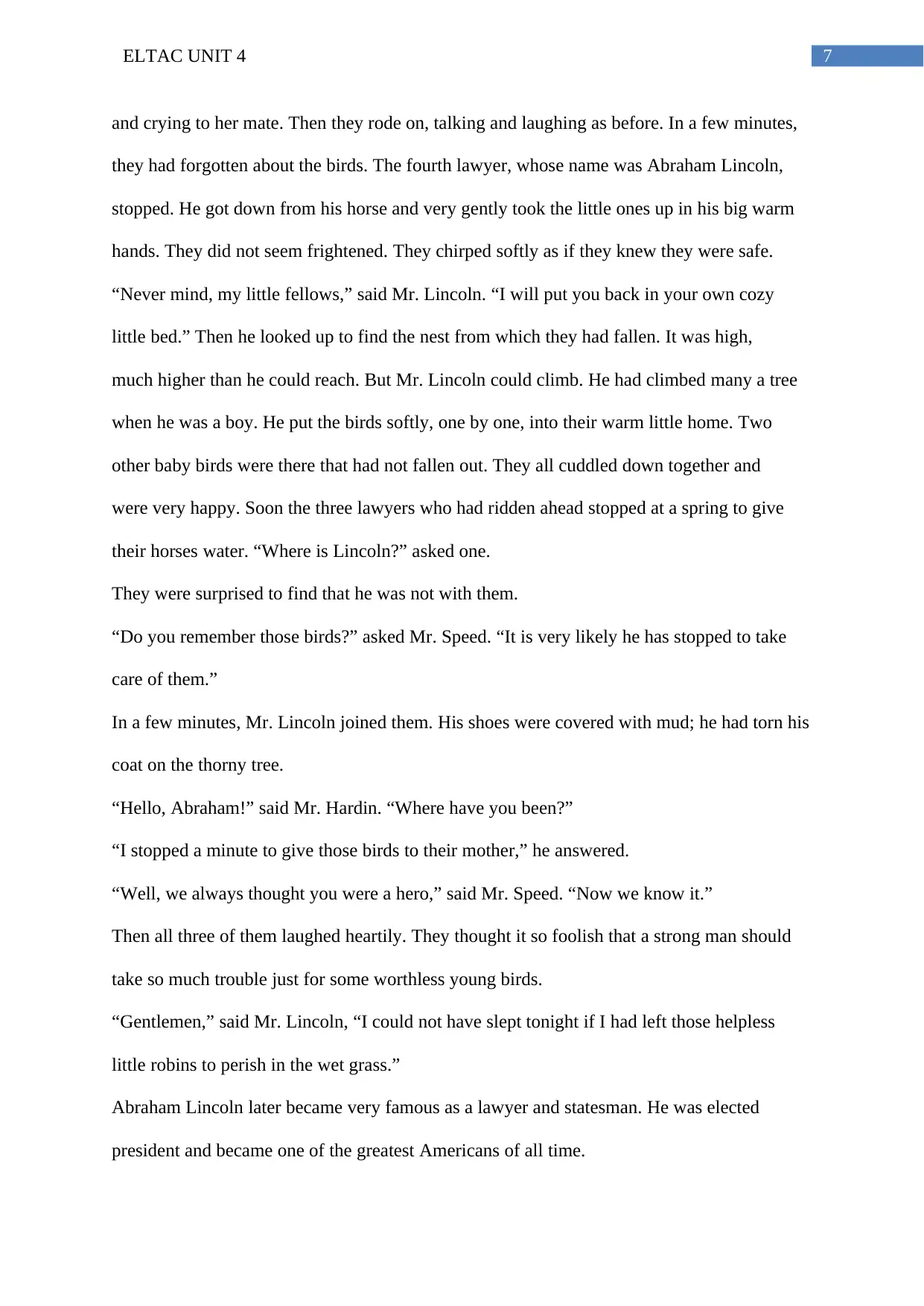
7ELTAC UNIT 4
and crying to her mate. Then they rode on, talking and laughing as before. In a few minutes,
they had forgotten about the birds. The fourth lawyer, whose name was Abraham Lincoln,
stopped. He got down from his horse and very gently took the little ones up in his big warm
hands. They did not seem frightened. They chirped softly as if they knew they were safe.
“Never mind, my little fellows,” said Mr. Lincoln. “I will put you back in your own cozy
little bed.” Then he looked up to find the nest from which they had fallen. It was high,
much higher than he could reach. But Mr. Lincoln could climb. He had climbed many a tree
when he was a boy. He put the birds softly, one by one, into their warm little home. Two
other baby birds were there that had not fallen out. They all cuddled down together and
were very happy. Soon the three lawyers who had ridden ahead stopped at a spring to give
their horses water. “Where is Lincoln?” asked one.
They were surprised to find that he was not with them.
“Do you remember those birds?” asked Mr. Speed. “It is very likely he has stopped to take
care of them.”
In a few minutes, Mr. Lincoln joined them. His shoes were covered with mud; he had torn his
coat on the thorny tree.
“Hello, Abraham!” said Mr. Hardin. “Where have you been?”
“I stopped a minute to give those birds to their mother,” he answered.
“Well, we always thought you were a hero,” said Mr. Speed. “Now we know it.”
Then all three of them laughed heartily. They thought it so foolish that a strong man should
take so much trouble just for some worthless young birds.
“Gentlemen,” said Mr. Lincoln, “I could not have slept tonight if I had left those helpless
little robins to perish in the wet grass.”
Abraham Lincoln later became very famous as a lawyer and statesman. He was elected
president and became one of the greatest Americans of all time.
and crying to her mate. Then they rode on, talking and laughing as before. In a few minutes,
they had forgotten about the birds. The fourth lawyer, whose name was Abraham Lincoln,
stopped. He got down from his horse and very gently took the little ones up in his big warm
hands. They did not seem frightened. They chirped softly as if they knew they were safe.
“Never mind, my little fellows,” said Mr. Lincoln. “I will put you back in your own cozy
little bed.” Then he looked up to find the nest from which they had fallen. It was high,
much higher than he could reach. But Mr. Lincoln could climb. He had climbed many a tree
when he was a boy. He put the birds softly, one by one, into their warm little home. Two
other baby birds were there that had not fallen out. They all cuddled down together and
were very happy. Soon the three lawyers who had ridden ahead stopped at a spring to give
their horses water. “Where is Lincoln?” asked one.
They were surprised to find that he was not with them.
“Do you remember those birds?” asked Mr. Speed. “It is very likely he has stopped to take
care of them.”
In a few minutes, Mr. Lincoln joined them. His shoes were covered with mud; he had torn his
coat on the thorny tree.
“Hello, Abraham!” said Mr. Hardin. “Where have you been?”
“I stopped a minute to give those birds to their mother,” he answered.
“Well, we always thought you were a hero,” said Mr. Speed. “Now we know it.”
Then all three of them laughed heartily. They thought it so foolish that a strong man should
take so much trouble just for some worthless young birds.
“Gentlemen,” said Mr. Lincoln, “I could not have slept tonight if I had left those helpless
little robins to perish in the wet grass.”
Abraham Lincoln later became very famous as a lawyer and statesman. He was elected
president and became one of the greatest Americans of all time.
1 out of 8
Related Documents
Your All-in-One AI-Powered Toolkit for Academic Success.
+13062052269
info@desklib.com
Available 24*7 on WhatsApp / Email
![[object Object]](/_next/static/media/star-bottom.7253800d.svg)
Unlock your academic potential
Copyright © 2020–2025 A2Z Services. All Rights Reserved. Developed and managed by ZUCOL.





